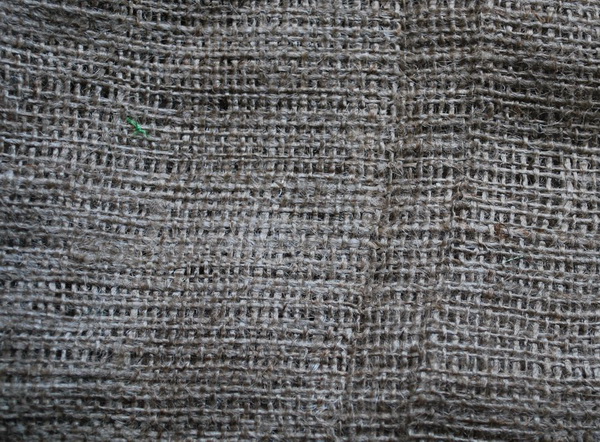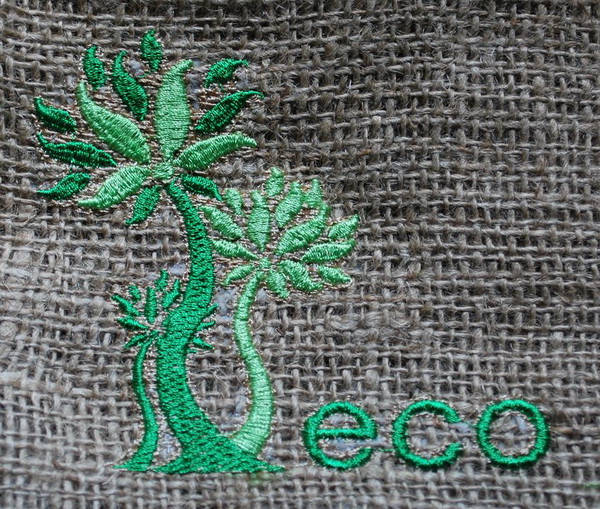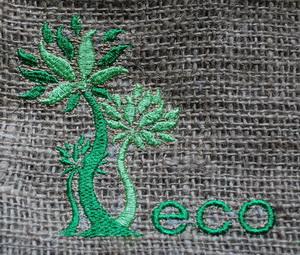Original text by Marina Belova
So, I've got to the Russian national material — burlap. Though I've already written about loosely woven fabrics, this may be considered a super-loosely woven one. There are only 4 or 5 strands per cm in burlap, and their variable thickness adds to the brain twister of design creation. But this is also what makes it interesting.
I have laid my eyes on a brand new vegetable sack, which I'm planning to use it in my experiment. I only have one attempt, so I hope everything will be fine.

Actually, the embroidery technique for the burlap is very similar to the one for other loosely woven fabrics; the only difference is that burlap surface has more texture. Therefore, much of the listed below is pretty obvious:
- Hoop the fabric and the backing – a semi-transparent cut-away spunbond or a piece of organza so that it wouldn't show between the yarns. If you aren't keen on saving up on the stabilizer, you can use a thick water soluble film. For my fabric, I would also add a temporary spray adhesive, just in case. Thin water soluble film goes on top to make the surface smoother.
- You can use the threads of any thickness and structure.
- Loosen the upper thread tension.
- Use the most ordinary needles matching the threads and the fabric in thickness. Sharp needlepoint is preferable.
- You also need to lower the speed a bit so that the loosely woven yarns aren't pulled.
To create a machine embroidery file, I:
- Picked a rather simple design to avoid excess stitches.
- Paid particular attention to the strengthening layer: an additional basting stitch at the very beginning of the embroidery would attach the fabric to the stabilizer. It outlined my future design, the basting stitch being of the same color as my burlap so that in case something went wrong it wouldn't be visible.
- I manually drew a lattice under the entire design. It would be of a matching color as well, provided that there was one in my collection.
- I made a complex edge run and zigzag underlay for wide satins. For narrow satins only edge run was used. A very open lattice at 90 + edge run was put under the fills.
- I set the density at 0.43–0.45 mm (my usual value).
- Increased pull compensation up to 0.5-0.6 mm on each side and also deliberately changed the shape of the outline to make it wider (I mentioned this in my article on pull compensation).
- I reduced satin stitch length to 3–4.5 mm in order to avoid the excess distortion.
With these settings I proceeded to the embroidery and got this:

I can't say that the result is outstanding: it needs correction. Mainly, the underlays – I should have given them more strength, like the ones for the FSL where the purity of the outline does not depend on the texture of the surface. But to do that I need to buy more burlap and try again. This sack is already full of potatoes. In my own opinion, the design for such a coarse fabric should on the big side, because small objects look ridiculous on this texture. One should not be afraid of using large elements in a case like this.
The first problem I encountered during the embroidery was the difficulty of hooping because this is not just cloth, but a garment. Special devices for such occasions once again popped in my mind.
Also, it is inconvenient to embroider such things on my home embroidery machine. In these circumstances, one fully understands the advantages of the "free arm embroidery" in the tubular hoops on commercial embroidery machines. In my case, it's the back side of the sack, but someone else struggles with the back of a T-shirt or a hoody. A free arm is usually kept under the rest of the working gear and does not interfere with your embroidery process. You don't have to rack your brain over positioning the garment properly so that is does not get stitched or loose in the hoop.


There are no reviews to display.